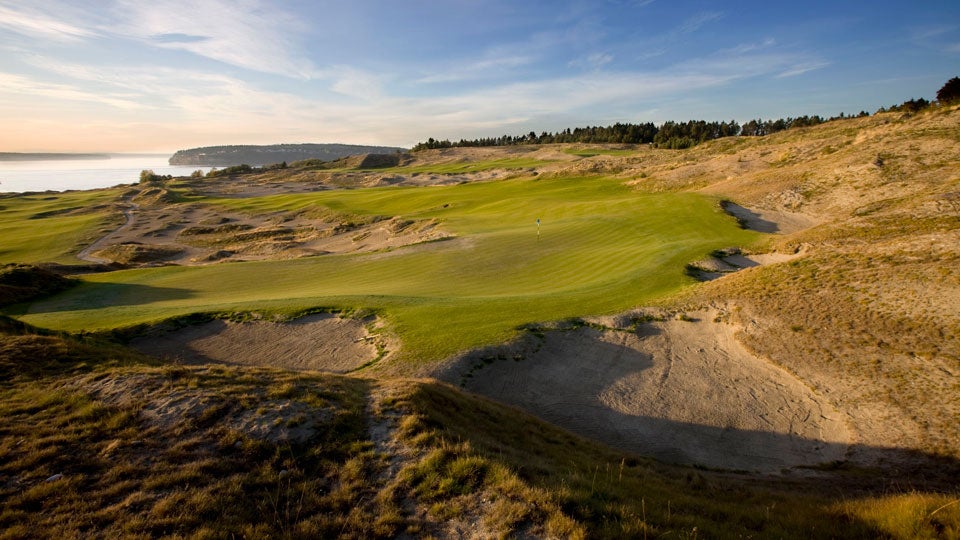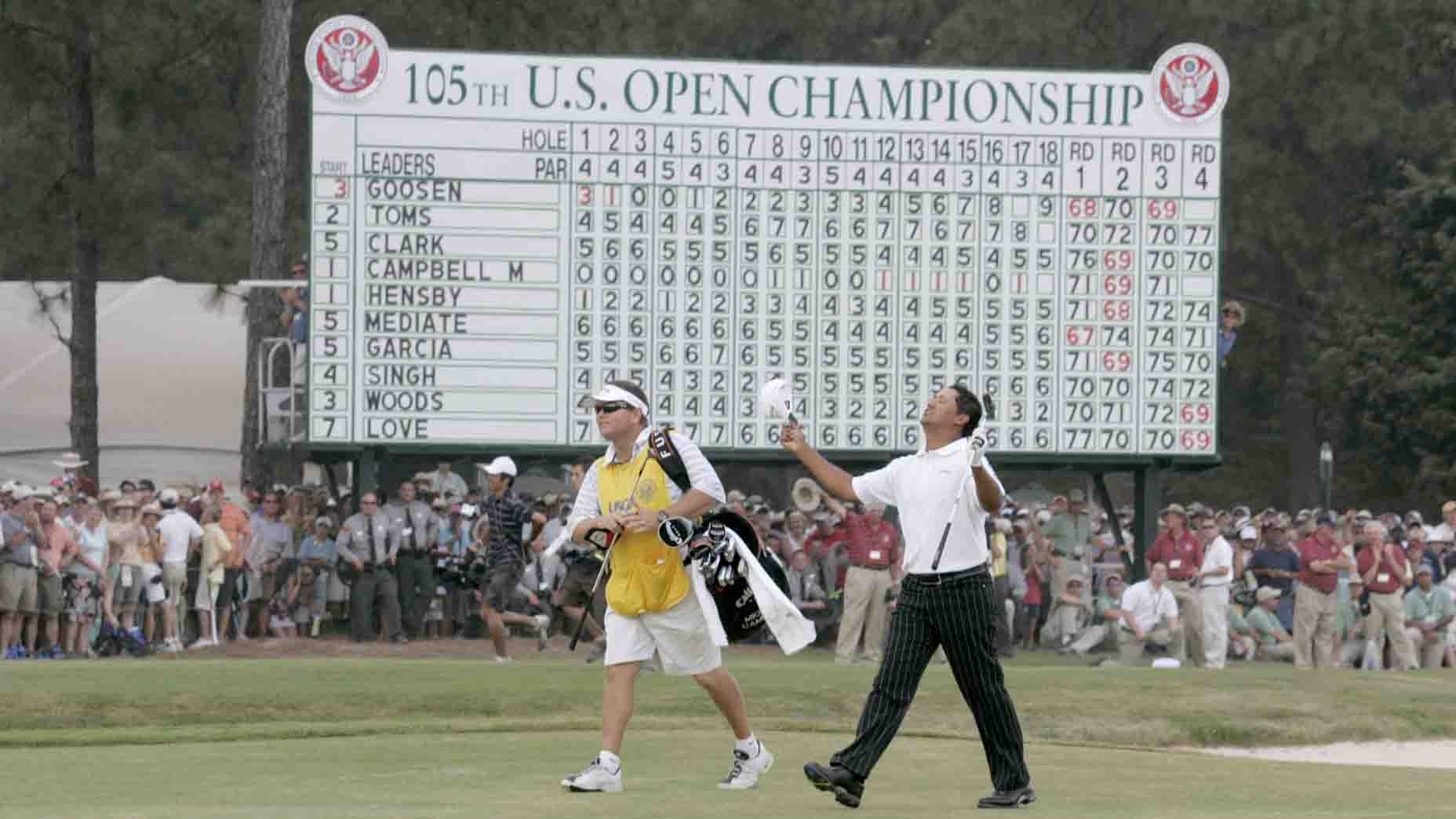To gaze upon Chambers Bay nearly a year after it hosted the U.S. Open is to be presented with enough shades of green to fill a box of crayons. If you consult the Crayola color chart, Chambers Bay features swaths of Fern and Asparagus, with splashes of Mountain Meadow and Granny Smith Apple. Notably, the putting surfaces are Maximum Green. Last year, during one of the most contentious Opens ever, Chambers Bay offered a decidedly different palette, all yellows and browns. The scorched earth was due to a historic heat wave and the USGA’s new commitment to environmentally friendly course setups. That philosophy of using less water began in 2014 with a baked-out Pinehurst No. 2, which memorably led Donald Trump to tweet that the course looked “horrible” while adding a pithy, “This is not what golf is about!” But Pinehurst is a traditional site in every other way, and because its greens rolled beautifully, that Open is remembered fondly by more sophisticated members of the golf firmament.
Chambers Bay was a radical new design with no track record in the professional game. Many players (and fans and reporters) simply didn’t get it, their collective frustration coalescing into shrill criticism of the greens that were bumpy at best. At worst, it was like “putting on broccoli,” said Henrik Stenson; Rory McIlroy countered, “I don’t think they’re as green as broccoli; I think they’re more like cauliflower.” McIlroy recently opened some old wounds when, in discussing Oakmont, he said, “Back to a nice traditional U.S. Open, not like we’re playing on the moon this year.”
But the criticism of Chambers Bay was at odds with its stellar leader board and epic finish. When the winner is Jordan Spieth and the top 10 includes Dustin Johnson, Louis Oosthuizen, Adam Scott, Charl Schwartzel, Jason Day and McIlroy, the course must be doing something right. There is a larger legacy to the first U.S. Open contested in the Pacific Northwest. Thanks to massive crowds and corporate support, it was a financial home run, pumping $134 million into the local economy. From the moment Chambers Bay opened in 2007 it was preparing for the Open and its warmup act, the 2010 U.S. Amateur. Now that the circus has left town, the municipally owned course is fulfilling its mission to serve the community.
Chambers is the only U.S. Open venue with an affiliated First Tee chapter, and it is now home to weekly matches of the PGA Junior League. Three colleges and two high schools call it home. Only a privileged few outsiders will ever get to play Oakmont, but Chambers Bay is open to all comers and can still be had for as low as $59—kids under 14 can play for free with a paid adult—and in the last year pilgrims have come from 49 states and 25 countries. Nine-hole and twilight rates have been added, along with “family” tees for beginners. Its excellent restaurant is a popular hangout for locals, and the walking trails that crisscross the property are far more crowded than the fairways. And Pierce County has cleaned up and opened to the public nearly two miles of new waterfront, including the pebbly beach that runs next to the 16th and 17th holes. Does Chambers Bay deserve another U.S. Open? A better question might be: After the damage inflicted upon the course’s reputation, does the U.S. Open deserve Chambers Bay?
The months leading up to last year’s Open were among the hottest on record for the Tacoma area, but as with every national championship venue, agronomical decisions were made to push the course further, in this case into the firm, fast test envisioned by designer Robert Trent Jones II. “There are no trees and no water hazards at Chambers Bay, so the defense of the course is in the contours and the turf,” says Jones. “It needs a hard, bouncy, runny, linkslike surface, so the ball doesn’t stop where it lands. You need that run-out to challenge the best players in the world because it forces them to strategize and to shape shots and effectively control their golf ball. Otherwise there’s nothing to overcome.”
Beginning around April Fool’s Day—2½ months ahead of the Open—watering was reduced by about 20% and the application of nitrogen fertilizer, which had typically been applied to the fairways and greens every three to four weeks, was halted. USGA agronomists and Chambers Bay greenkeepers were banking on the usual rainfall, but it never came as the area roasted in cloudless days in the mid-80s. By the time USGA executive director Mike Davis arrived on site, two weeks ahead of the first round, the course was already fiery and there was no Crayola green to be seen. “I never dreamed we would have the weather that allowed us to get the course to look this way,” Davis told Chambers Bay staffers. “This is awesome.”
But a chain reaction had already begun with the greens. Among the many firsts that came with Chambers Bay was its fine fescue greens; no U.S. Open had ever been played on this grass, which is more common on the ancient links courses of the British Isles. Fescue does well in Tacoma’s traditionally cool maritime climate, but in the blazing heat the grass went dormant in an act of survival. Complicating matters, the greens are not exclusively fescue—there are also strains of bentgrass and poa annua, and the mix varied from surface to surface. For example, the elevated 18th green, with plentiful exposure to the sun and wind, was approximately 5% poa, 20% bent and the rest fescue. The 12th, tucked into a shady amphitheater, was roughly 30% poa and 30% bent. While the fescue laid down in the heat, the poa’s last gasp for survival was to sprout white seed-heads. Watering only exacerbated the difference—the fescue stayed dormant, but the poa stood straight up, the seed-heads blooming enough to make a golf ball wobble. Three or four times in the run-up to the Open the greens were “brushed and groomed” with special devices to smooth the surface and make all of the grasses a uniform height to allow for a cleaner cut by the mowers. But this process also makes the greens run significantly faster. Given Chambers’s heaving undulations, Jones believed the ideal speed for the greens was 10 on the Stimpmeter, 11 tops. As the tournament loomed, the USGA pushed it to 12. Fearful the speed would get out of control, the brushing and grooming was stopped two weeks before the start of the tournament. Thus the die was cast: The greens would be mottled in color, and because a variety of grasses were featured, the blades would act quite differently in the heat.

There has long been a persistent rumor that the USGA panicked at the 11th hour and applied a chemical to the greens in hopes of stimulating growth, but multiple sources close to the situation dispute this. It would be some consolation to have a bad guy to blame for compromising Chambers Bay’s greens, but in reality there’s not much to second-guess. More water and more fertilizer would have given the greens more color, but they still would have been bumpy. The brushing and grooming could have been saved for tournament week, but that would have been risky given the potential for the speed to get out of hand. Keeping them slower would have allowed for more smoothing but reduced the overall test of the course. “I’m at peace,” says Darin Bevard, the USGA’s director of championship agronomy. “I guess I’ve been in the business long enough to understand the impacts that weather can have on growing grass and conditioning a golf course. I am disappointed that the weather was the way it was leading up to and during that U.S. Open. That hot, dry weather just didn’t allow us to prepare the golf course the way we would have liked.”
Bevard can retain his equanimity because he gets to do an Open every year. For the Chambers Bay staff the criticism was deeply personal. “It was like having a bunch of people go on international TV and say your kid is ugly,” says one member of the greenkeeping staff who spoke on the condition of anonymity. “It hurt. A lot.” As Open week wore on, a bitterness set in toward some of the players. “The guys who were out there complaining nonstop—your Billy Horschels, your Sergio Garcías, your Henrik Stensons, your Ian Poulters—I added up their major championship titles, and I went, Wait a minute. I’ve won as many majors as they have,” says the greenkeeper. “Maybe something else is going on here. Maybe the players who complain are the ones who are too weak mentally to win a U.S. Open.” When the telecast would show misfortune befalling any of the above players, the break room for the greenkeeping staff would erupt in cheers.
Horschel frames his comments—”I’ve hit a lot of good putts that have bounced all over the world …. Number 4 green is god-awful … 10, that hole is in dirt”—as a principled stand whereby he had the courage to speak truth to power. “I was trying to stick up for my fellow players and make a statement,” he says now. “I knew I’d get blasted, but I felt like fans weren’t getting the real story and they needed to hear it from someone. Mike Davis kept saying, ‘They putt better than they look.’ The commentators kept saying on air that the greens were perfect. Obviously this being the first year of coverage for Fox, they were trying not to ruin their relationship with the USGA. But I felt the players were being disrespected. Look at the stats: 99.8% of the time on Tour we make three-footers. Now all of sudden everybody is missing three-footers? It’s not because it’s the U.S. Open, it’s not because of pressure; it’s the greens, plain and simple.”
As part of a 12-year contract that was announced in August 2013, Fox paid roughly $100 million a year for the rights to a slate of USGA events, and to kick off the deal, the network was given what coordinating producer Mark Loomis calls “easily the toughest Open course ever, logistically.” With Fox already scrambling on any number of fronts, the mushrooming controversy over the greens put the network in a defensive crouch. “The players who complained were right,” says Fox’s lead analyst in 2015, Greg Norman, who was fired in January. Norman claims that even before the Open began, he lobbied for an in-depth feature on the condition of the greens. “I thought it was a very compelling story, and it was important to have an honest discussion about what went wrong,” he says. “In the infinite wisdom of my producer”—he declined to name names—”they decided not to do it. Was that an editorial decision, or were they afraid of the USGA? I don’t know.”
Asked about this, Loomis says, “I’m not sure what he’s talking about.” Speaking more generally, he says, “Look, we value our relationship with the USGA, like any network values its relationships with their partners. But that did not affect how we covered the story. We gave a lot of airtime to the issue of the greens. We let the players tell their side of things, and we gave Mike Davis a platform to speak for the USGA. On the weekend, and especially Sunday, we focused on the leader board and the incredible on-course action, and I have no doubt that’s what golf fans wanted.”
Indeed, the final round was one of the most exciting in U.S. Open history: Scott’s 64; McIlroy’s five birdies in six holes; Oosthuizen’s back-nine 29; Spieth’s roller-coaster rally; the riveting 72nd-hole drama capped by Johnson’s fatal three-putt.
“When you look back at it, of course Chambers Bay should get another U.S. Open,” says Oosthuizen, the 2010 British Open champ. “You had the best players in the world putting on quite a show, and that’s a credit to the golf course. When you look at the trophy, it has a year and a name. That’s all. There’s no room to talk about the length of rough or the condition of greens or if the fairways were hard or soft. In the end none of that matters. The score is what matters.”
One of the standard bearers at the Open was William Harris, who had just finished his freshman year at Clover Park High in Lakewood. William came to golf through the First Tee of South Puget Sound, at which the bulk of the 1,400 kids are “at risk and underserved,” according to Tracy Peacock, the chapter’s executive director. William worked hard on his game, and when he was finally ready to leave the driving range, the first course he played was Chambers Bay. “It was an amazing experience,” he says. “It was silent. I could feel the wind. It was really relaxing, really peaceful. It was like escaping everyday life for a while.”
William was wowed by the pageantry of Open week and still keeps a cache of signed golf balls. “The players are hecka-famous, but I don’t really remember their names,” he says. His First Tee chapter supplied 225 other volunteers to staff a concession stand throughout the week, an important fund-raising vehicle for a First Tee at which two-thirds of the kids are “on scholarship,” which is to say, many pay nothing. “It was like the World’s Fair came to little Tacoma,” says Peacock. “The community pulled together to make it happen. We all love Chambers Bay. There is a tremendous pride here at having hosted a U.S. Open. We’re eager to do it again.”
The courtship of the USGA is ongoing. Before the end of 2016, Chambers Bay leadership is confident it will be able to announce that the course is hosting a U.S. Women’s Open, with ’22 being the first available year. By then a boutique hotel could be on the property; Pierce County is in negotiations with a couple of developers. Any new structure will include locker rooms and clubhouse components that are now lacking.
Upgrading the infrastructure can only help Chambers Bay land more tournaments. Improving the fan experience will be essential; Horschel, García and many other players said last year they felt sorry for the spectators who were inefficiently herded around the property. Jones has already submitted to Pierce County a detailed plan for improved walking routes that would allow for additional grandstands, including some big ones on the hillside framing the 8th hole, which became a metaphor of sorts when no fans were allowed on its severe terrain.
“The USGA’s main concern was driven by insurance, in my opinion,” says Jones. “They didn’t want spectators slipping on the dunes and breaking their legs and suing. Well, those dunes are man-made. They’re not sacred. We can cut trails through them or flatten some of them or even move dunes entirely. There are plenty of ways to get fans up on the hillside at number 8, or behind the 13th green or the 17th tee. The fact is, it’s important to Chambers Bay’s legacy to get another U.S. Open. So whatever the USGA wants improved, it’ll get done because there is tremendous public support and political will there.”
Davis was unavailable for comment for this story, but Chambers Bay general manager Matt Allen says, “We believe the USGA when they say it’s a matter of when, not if, we’ll get another U.S. Open. Part of hosting other championships is to continue the relationship and continue the dialogue and give USGA folks a regular opportunity to visit. You give the greens more time to evolve and give us more typical weather, and I have zero doubt we’ll have wonderful, smooth putting surfaces. That’s part of why we want to host other championships—to prove that.”
Next week the eyes of the golf world will be upon Oakmont. No doubt players will whine about the speed of the greens and the thickness of the rough and perhaps even the fluffiness of the towels in the locker room; kvetching is the soundtrack to every Open. At Chambers Bay it will be business as usual. The tee sheet is packed, and many of these every-day golfers will end their rounds by walking to the back of the 18th green to look at the spot from which Johnson infamously three-putted. As is customary, many will drop a ball and try the downhill putt for themselves, getting to experience a little piece of history. Expect most to run their putt far past the imaginary hole, because these days the greens are rolling quite nicely.







